Description: This annual plant is ½–3' tall, branching sparingly. The central stem is glabrous and occasionally angular. The opposite leaves are up to 5" long and 1" across, although usually smaller in size. They are linear-oblong to lanceolate-ovate, serrated along the margins, and hairless. These leaves are never lobed nor pinnately compound. At the base, the pairs of opposite leaves clasp the stem and nearly surround it (i.e., they're nearly connate), or they are sessile. The upper stems terminate in flowerheads about ½–1½" across. These flowerheads have a tendency to nod downward with age and the central head of disk florets becomes larger and more rounded. The corolla of each disk floret is yellow and narrowly tubular with 5 lobes. There are about 8 ray florets surrounding the disk florets, but sometimes they lack petaloid rays. When they are present, the petaloid rays are bright yellow and oblong-elliptic in shape; they are variable in length, depending on the local ecotype.
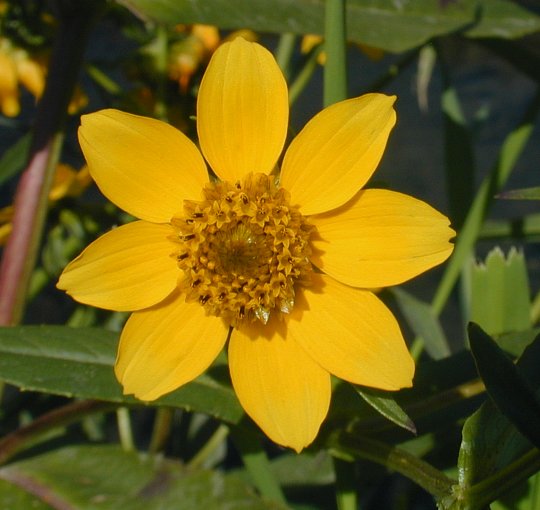
At the base of each flowerhead, there are both inner and outer bracts (phyllaries). The inner bracts are pale yellow, membranous along their margins, and rather broad, tapering to blunt tips. The outer bracts are green and oblong-linear. These latter bracts are about as long or longer than the petaloid rays, but they have a tendency to curl backward with age. There are about 6-10 outer bracts per flowerhead. The blooming period occurs from late summer to early fall and lasts about 1-2 months for a colony of plants. Each achene is oblongoid, although broader and somewhat truncated at its apex, where there are usually 4 barbed awns. The root system is shallow and branches frequently. This plant often forms colonies and spreads by reseeding itself; sometimes the lower portion of a stem will form rootlets at the leaf nodes when it lies against moist soil. Nodding Bur-Marigold is rather variable across its range. The leaves have a tendency to turn purple during the cool weather of autumn.
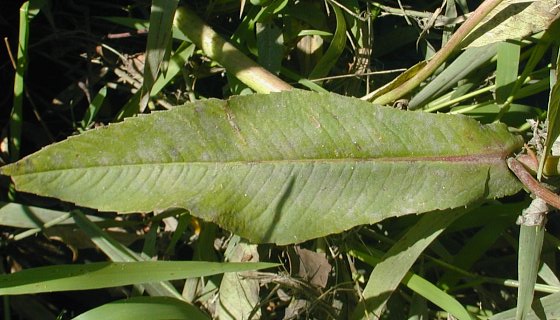
Cultivation:
The
preference is full or partial sun, wet conditions, and mucky soil.
Occasional flooding is readily tolerated, although this species is not
an emergent aquatic. Sometimes the leaves succumb to powdery mildew
during the fall. This plant is less tolerant of dry conditions than
other Bidens spp.
Range & Habitat:
The native Nodding Bur-Marigold is common in central and northern
Illinois, but
occasional to absent in southern Illinois (see Distribution
Map). Habitats include swamps, bogs, seeps, marshes, edges of
rivers and ponds, soggy meadows in floodplain areas, and ditches along
roads and railroads. Nodding Bur-Marigold is often found in degraded
wetlands, although it also occurs in higher quality wetlands.
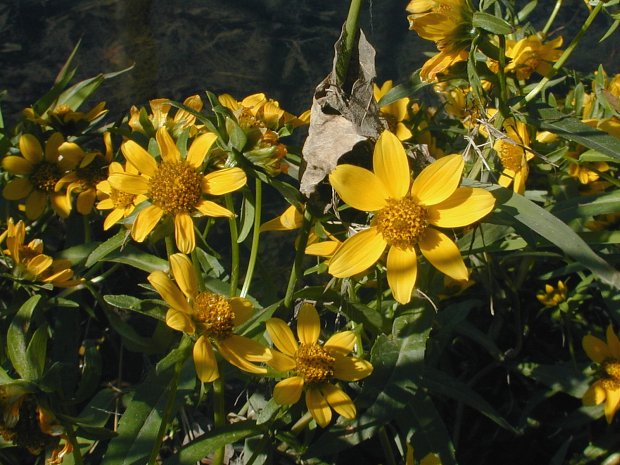
Faunal Associations: Plants with showier flowers attract an abundance of bees, wasps, butterflies, skippers, moths, and various kinds of flies. Bee visitors include honey bees, bumblebees, long-horned bees (Melissodes spp.), leaf-cutting bees (Megachile spp.), and plasterer bees (Colletes spp.). These insects suck nectar from the flowers; bees also collect pollen. The caterpillars of the butterfly Nathalis iole (Dainty Sulfur) feed on the foliage. The caterpillars of several species of moths also feed on Bidens spp., including Epiblema otiosana (Bidens Borer Moth), Cirrhophanus triangulifer (Goldenrod Stowaway), Condica mobilis (Mobile Groundling), and Condica confederata (The Confederate). Other insect feeders the leaf beetles Calligrapha bidenticola and Calligrapha californica, the fruit fly Icterica seriata, and several aphid species.
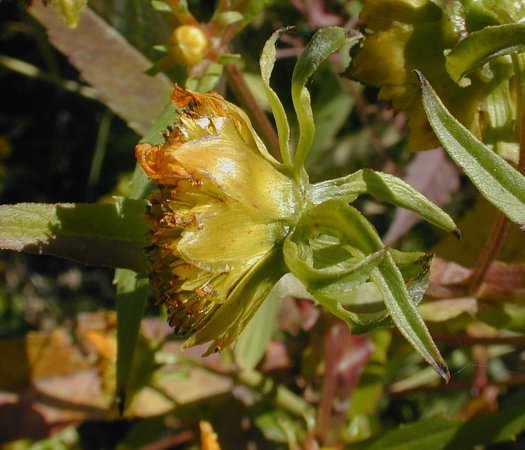
To a limited
extent, the seeds of Bidens spp. are eaten by
various kinds of birds, including the Mallard Duck, Swamp Sparrow,
Purple Finch, and Common Redpoll (the latter during the winter). The
foliage is occasionally eaten by the Cottontail Rabbit. The seeds of Bidens
spp. are notorious for their ability to cling to the fur of
animals, the feathers of birds, or the clothing of humans, by which
means they are distributed far and wide.
Photographic Location:
Along a drainage canal in Champaign, Illinois.
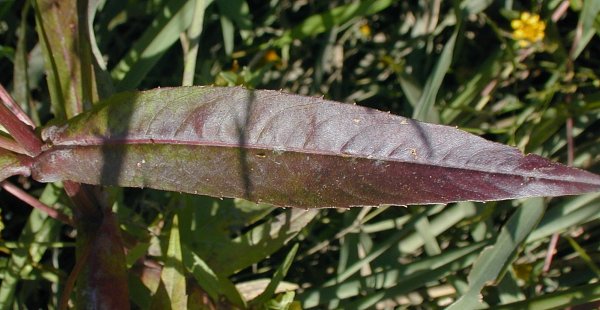
Comments: The attractiveness of the flowers is variable, depending upon the length of the petaloid rays, which are not always present. It is fairly easy to distinguish Nodding Bur-Marigold from other Bidens spp. because of its undivided leaves and achenes with 4 awns (rarely fewer). Plants with flowerheads that are large and showy can resemble Bidens laevis (Smooth Bur-Marigold), but this latter species doesn't occur in Illinois. The petaloid rays of Smooth Bur-Marigold are at least as long as the outer floral bracts (phyllaries) and it usually has showier flowers. When the flowerheads of Nodding Bur-Marigold lack petaloid rays, this species can be confused with Bidens connata (Purple-Stemmed Beggar's Tick) and Bidens comosa (Swamp Beggar's Tick). Nodding Bur-Marigold differs from these latter species by its leaves, which are sessile or they clasp and nearly surround the stem. Purple-Stemmed Beggar's Tick and Swamp Beggar's Tick have leaves with distinct petioles that are winged or unwinged. The flowerheads of Nodding Bur-Marigold nod downward with age, while the flowerheads of the latter two species usually remain more erect.